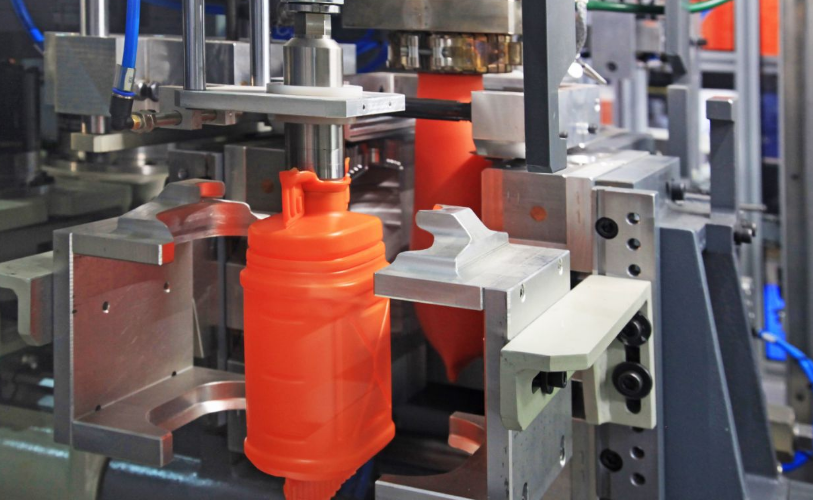Rotoplastic excels due to its seamless, stress-free production of complex, durable products, surpassing injection molding’s limitations.
Fundamentals of Rotational Molding vs. Injection Molding
Rotational Molding and Injection Molding stand as two pivotal techniques in the manufacturing sector, each boasting unique processes and results. This comprehensive comparison aims to shed light on their efficiencies, costs, and quality.

Process Overview of Rotational Molding
Rotational Molding, also known as Rotomolding, excels in creating large, hollow objects. The process involves:
Heating Phase: Load a pre-measured amount of plastic resin into a mold. Heat the mold in an oven while rotating it along two perpendicular axes to ensure even distribution of the plastic.
Cooling Phase: After heating, cool the mold under controlled conditions to solidify the plastic.
Demolding Phase: Remove the final product from the mold.
This process can take 45 minutes to 3 hours, varying with the product’s size and thickness.
Process Overview of Injection Molding
Injection Molding is ideal for high-volume, intricate plastic parts production. The key steps include:
Melting: Melt plastic pellets and inject them under high pressure into a mold cavity.
Cooling and Solidification: Let the injected plastic cool and solidify, forming the shape of the mold.
Ejection: Eject the solidified part from the mold.
This process typically lasts 30 seconds to 2 minutes per cycle, making it much faster than rotational molding.
Material Efficiency and Cost Comparison
Rotational Molding:
Material Utilization: Achieves high efficiency with minimal wastage as it uses the entire plastic charge in forming the product.
Cost Factors: Offers lower tooling costs but incurs higher raw material costs per part. It’s ideal for short-run productions.
Quality: Ensures durable, stress-free products with uniform wall thickness.
Speed: Slower due to lengthy cycle times.
Injection Molding:
Material Utilization: Efficient, though runners and sprues can cause wastage.
Cost Factors: Involves high initial tooling costs but reduces per-part material costs. Economical for large-scale production.
Quality: Allows production of highly detailed and complex parts.
Speed: Offers a faster production rate with shorter cycle times.
Explore more on the Rotational Molding Wikipedia page and the Injection Molding Wikipedia page.
Material Efficiency and Cost Comparison
Material Utilization in Rotational Molding
Rotational Molding optimizes material utilization by minimizing wastage. The process involves placing the exact amount of material needed for the product into the mold, resulting in virtually no excess.
Material Wastage: Negligible, as the entire amount of plastic used forms the product.
Efficiency: High material efficiency, especially suitable for large, hollow products.
Product Quality: Ensures uniform wall thickness and material distribution.
Material Costs in Injection Molding
Injection Molding, while efficient, can experience some material wastage due to its process specifics.
Material Wastage: Occurs mainly in the form of runners, sprues, and gates.
Efficiency: High efficiency for high-volume production.
Product Quality: Capable of producing complex shapes with high precision.
Comparison Table:
| Feature | Rotational Molding | Injection Molding |
|---|---|---|
| Material Wastage | Very Low | Moderate (due to runners and sprues) |
| Efficiency | High for large items | High for mass production |
| Cost per Unit | Higher for small runs | Lower for large quantities |
| Suitability | Large, hollow products | Complex, detailed items |
| Cycle Time | Longer (45 min – 3 hrs) | Shorter (30 sec – 2 min) |
| Tooling Costs | Lower | Higher |
| Design Flexibility | High | Moderate |
Explore more on Rotational Molding and Injection Molding to understand their applications and advancements.
Analysis of Product Quality and Precision
Uniformity and Strength in Rotational Molding Products
Rotational Molding stands out in creating uniformly thick and strong products. This method ensures:
Even Thickness: Rotational motion spreads the material evenly across the mold.
Strength: Products exhibit excellent environmental stress-cracking resistance.
Durability: These products often have a longer lifespan due to their uniformity.
Precision and Detail in Injection Molding Products
Injection Molding excels in delivering precision and detail. Key attributes include:
High Precision: Achieves tight tolerances up to ±0.005 inches.
Complex Designs: Ideal for intricate shapes and fine details.
Consistency: Ensures uniform production across large volumes.
Quality Comparison:
Wall Thickness:
Rotational Molding: Consistent, ideal for hollow parts.
Injection Molding: Precise control, suitable for complex geometries.
Tolerance Levels:
Rotational Molding: Generally ±0.015 inches.
Injection Molding: As tight as ±0.005 inches.
Surface Finish:
Rotational Molding: Smooth surfaces with minor limitations in complexity.
Injection Molding: Excellent, supports textures and fine finishes.
Material Impact:
Rotational Molding: Uses polyethylene, known for its durability.
Injection Molding: Works with a wide range of plastics, allowing for varied properties.
For further insights, visit Rotational Molding and Injection Molding on Wikipedia.
Production Efficiency and Scalability
Batch Production Capabilities of Rotational Molding
Rotational Molding is optimal for small to medium-sized batch production. It offers:
Flexibility in Quantity: Handles varying production scales, from few to several thousand units.
Cycle Time: Each cycle ranges from 45 minutes to 3 hours, depending on product size and complexity.
Energy Consumption: Generally consumes less energy per cycle compared to injection molding.
Speed and Scale Advantages of Injection Molding

Injection Molding shines in high-speed, large-scale production. Its advantages include:
High Volume Efficiency: Excellently suited for producing tens of thousands to millions of parts.
Cycle Time: Rapid cycles, typically 30 seconds to 2 minutes.
Scalability: Easily scales up to meet high demand.
Efficiency Comparison:
Energy Usage:
Rotational Molding: Lower per cycle, but longer cycle times.
Injection Molding: Higher per cycle, but more parts per hour.
Setup Time:
Rotational Molding: Longer for initial setup.
Injection Molding: Quick setup, ideal for continuous runs.
Cost Implications:
Rotational Molding: More cost-effective for smaller runs.
Injection Molding: Reduced cost per part at high volumes.
For more details, explore Rotational Molding and Injection Molding on Wikipedia.




